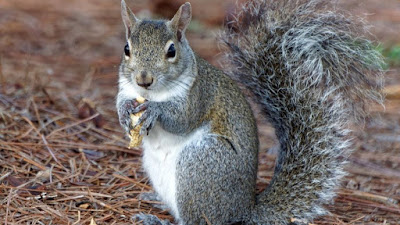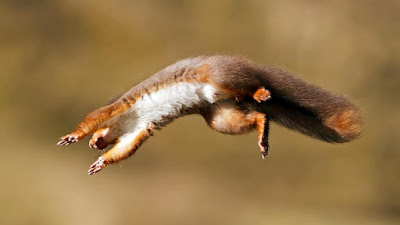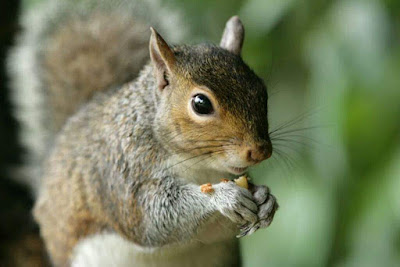Squirrels are members of the family Sciuridae, a family that includes small or medium-size rodents. The squirrel family includes tree squirrels, ground squirrels, chipmunks, marmots (including woodchucks), flying squirrels, and prairie dogs amongst other rodents. Squirrels are indigenous to the Americas, Eurasia, and Africa, and were introduced by humans to Australia.The earliest known squirrels date from the Eocene period and are most closely related to the mountain beaver and to the dormouse among other living rodent families.
Characteristics
 Squirrels are generally small animals, ranging in size from the African pygmy squirrel at 7–10 cm (2.8–3.9 in) in length and just 10 g (0.35 oz) in weight, to the Laotian giant flying squirrel at 1.08 m (3 ft 7 in) in length and the Alpine marmot, which weighs from 5 to 8 kg (11 to 18 lb). Squirrels typically have slender bodies with bushy tails and large eyes. In general, their fur is soft and silky, although much thicker in some species than others. The color of squirrels is highly variable between—and often even within—species.
Squirrels are generally small animals, ranging in size from the African pygmy squirrel at 7–10 cm (2.8–3.9 in) in length and just 10 g (0.35 oz) in weight, to the Laotian giant flying squirrel at 1.08 m (3 ft 7 in) in length and the Alpine marmot, which weighs from 5 to 8 kg (11 to 18 lb). Squirrels typically have slender bodies with bushy tails and large eyes. In general, their fur is soft and silky, although much thicker in some species than others. The color of squirrels is highly variable between—and often even within—species.
In general, the hind limbs are longer than the fore limbs, and they have four or five toes on each paw. Their paws include an often poorly developed thumb, and have soft pads on the undersides.Unlike most mammals, Tree squirrels can descend a tree head-first. They do so by rotating their ankles 180 degrees so the hind paws are backward-pointing and can grip the tree bark.
Squirrels live in almost every habitat from tropical rainforest to semiarid desert, avoiding only the high polar regions and the driest of deserts. They are predominantly herbivorous, subsisting on seeds and nuts, but many will eat insects and even small vertebrates.
 As their large eyes indicate, in general squirrels have an excellent sense of vision, which is especially important for tree-dwelling species. They also have very versatile and sturdy claws for grasping and climbing.[9] Many also have a good sense of touch, with vibrissae on their heads and limbs.The teeth of sciurids follow the typical rodent pattern, with large gnawing incisors that grow throughout life, and grinding cheek teeth set back behind a wide gap, or diastema. The typical dental formula for sciurids is 1.0.1.3 1.0.1.3 .
As their large eyes indicate, in general squirrels have an excellent sense of vision, which is especially important for tree-dwelling species. They also have very versatile and sturdy claws for grasping and climbing.[9] Many also have a good sense of touch, with vibrissae on their heads and limbs.The teeth of sciurids follow the typical rodent pattern, with large gnawing incisors that grow throughout life, and grinding cheek teeth set back behind a wide gap, or diastema. The typical dental formula for sciurids is 1.0.1.3 1.0.1.3 .
Many juvenile squirrels die in the first year of life. Adult squirrels can have a lifespan of 5 to 10 years in the wild. Some can survive 10 to 20 years in captivity.
Some causes of premature death include nests which have fallen out of trees, of which the mother will leave the young if the body temperature is not correct. Many squirrels have been rescued by people prompting fostering of baby squirrels or wildlife rehabilitators before turning them back into the wild.
Behavior
 Squirrels breed once or twice a year and give birth to a varying number of young after three to six weeks, depending on species. The young are born naked, toothless, and blind. In most species of squirrel, only the female looks after the young, which are weaned at around six to ten weeks of age and become sexually mature at the end of their first year. In general, ground-dwelling species are social animals, often living in well-developed colonies, but the tree-dwelling species are more solitary.
Squirrels breed once or twice a year and give birth to a varying number of young after three to six weeks, depending on species. The young are born naked, toothless, and blind. In most species of squirrel, only the female looks after the young, which are weaned at around six to ten weeks of age and become sexually mature at the end of their first year. In general, ground-dwelling species are social animals, often living in well-developed colonies, but the tree-dwelling species are more solitary.
Ground and tree squirrels are typically diurnal or crepuscular,while flying squirrels tend to be nocturnal—except for lactating flying squirrels and their offspring, which have a period of diurnality during the summer.
Feeding
 Squirrels cannot digest cellulose, so they must rely on foods rich in protein, carbohydrates, and fats. In temperate regions, early spring is the hardest time of year for squirrels, because buried nuts begin to sprout and are no longer available for the squirrel to eat, and new food sources have not become available yet. During these times, squirrels rely heavily on the buds of trees. Squirrels' diets consist primarily of a wide variety of plants, including nuts, seeds, conifer cones, fruits, fungi, and green vegetation. However, some squirrels also consume meat, especially when faced with hunger.[8] Squirrels have been known to eat insects, eggs, small birds, young snakes, and smaller rodents. Indeed, some tropical species have shifted almost entirely to a diet of insects.
Squirrels cannot digest cellulose, so they must rely on foods rich in protein, carbohydrates, and fats. In temperate regions, early spring is the hardest time of year for squirrels, because buried nuts begin to sprout and are no longer available for the squirrel to eat, and new food sources have not become available yet. During these times, squirrels rely heavily on the buds of trees. Squirrels' diets consist primarily of a wide variety of plants, including nuts, seeds, conifer cones, fruits, fungi, and green vegetation. However, some squirrels also consume meat, especially when faced with hunger.[8] Squirrels have been known to eat insects, eggs, small birds, young snakes, and smaller rodents. Indeed, some tropical species have shifted almost entirely to a diet of insects. Predatory behavior has been noted by various species of ground squirrels, in particular the thirteen-lined ground squirrel.For example, Bailey, a scientist in the 1920s, observed a thirteen-lined ground squirrel preying upon a young chicken.Wistrand reported seeing this same species eating a freshly killed snake.Whitaker examined the stomachs of 139 thirteen-lined ground squirrels and found bird flesh in four of the specimens and the remains of a short-tailed shrew in one;Bradley, examining white-tailed antelope squirrels' stomachs, found at least 10% of his 609 specimens' stomachs contained some type of vertebrate, mostly lizards and rodents.Morgart observed a white-tailed antelope squirrel capturing and eating a silky pocket mouse.
Predatory behavior has been noted by various species of ground squirrels, in particular the thirteen-lined ground squirrel.For example, Bailey, a scientist in the 1920s, observed a thirteen-lined ground squirrel preying upon a young chicken.Wistrand reported seeing this same species eating a freshly killed snake.Whitaker examined the stomachs of 139 thirteen-lined ground squirrels and found bird flesh in four of the specimens and the remains of a short-tailed shrew in one;Bradley, examining white-tailed antelope squirrels' stomachs, found at least 10% of his 609 specimens' stomachs contained some type of vertebrate, mostly lizards and rodents.Morgart observed a white-tailed antelope squirrel capturing and eating a silky pocket mouse.
Taxonomy
The living squirrels are divided into five subfamilies, with about 58 genera and some 285 species.The oldest squirrel fossil, Hesperopetes, dates back to the Chadronian (late Eocene, about 40–35 million years ago) and is similar to modern flying squirrels.
A variety of fossil squirrels, from the latest Eocene to the Miocene, could not be assigned with certainty to any living lineage. At least some of these probably were variants of the oldest basal "protosquirrels" (in the sense that they lacked the full range of living squirrels' autapomorphies). The distribution and diversity of such ancient and ancestral forms suggest the squirrels as a group may have originated in North America.
 Apart from these sometimes little-known fossil forms, the phylogeny of the living squirrels is fairly straightforward. The three main lineages are the Ratufinae (Oriental giant squirrels), Sciurillinae and all other subfamilies. The Ratufinae contain a mere handful of living species in tropical Asia. The neotropical pygmy squirrel of tropical South America is the sole living member of the Sciurillinae. The third lineage, by far the largest, has a near-cosmopolitan distribution. This further supports the hypothesis that the common ancestor of all squirrels, living and fossil, lived in North America, as these three most ancient lineages seem to have radiated from there; if squirrels had originated in Eurasia, for example, one would expect quite ancient lineages in Africa, but African squirrels seem to be of more recent origin.
Apart from these sometimes little-known fossil forms, the phylogeny of the living squirrels is fairly straightforward. The three main lineages are the Ratufinae (Oriental giant squirrels), Sciurillinae and all other subfamilies. The Ratufinae contain a mere handful of living species in tropical Asia. The neotropical pygmy squirrel of tropical South America is the sole living member of the Sciurillinae. The third lineage, by far the largest, has a near-cosmopolitan distribution. This further supports the hypothesis that the common ancestor of all squirrels, living and fossil, lived in North America, as these three most ancient lineages seem to have radiated from there; if squirrels had originated in Eurasia, for example, one would expect quite ancient lineages in Africa, but African squirrels seem to be of more recent origin.
The main group of squirrels also can be split into three subgroups, which yield the remaining subfamilies. The Sciurinae contains the flying squirrels (Pteromyini) and the Sciurini, which among others contains the American tree squirrels; the former have often been considered a separate subfamily, but are now seen as a tribe of the Sciurinae. The pine squirrels (Tamiasciurus), on the other hand, are usually included with the main tree squirrel lineage, but appear to be about as distinct as the flying squirrels; hence, they are sometimes considered a distinct tribe, Tamiasciurini.
 Two of the three subfamilies are of about equal size, containing between nearly 70 and 80 species each; the third is about twice as large. The Sciurinae contains arboreal (tree-living) squirrels, mainly of the Americas and to a lesser extent Eurasia. The Callosciurinae is most diverse in tropical Asia and contains squirrels that are also arboreal, but have a markedly different habitus and appear more "elegant", an effect enhanced by their often very colorful fur. The Xerinae—the largest subfamily—are made up from the mainly terrestrial (ground-living) forms and include the large marmots and the popular prairie dogs, among others, as well as the tree squirrels of Africa; they tend to be more gregarious than other squirrels, which do not usually live together in close-knit groups.
Two of the three subfamilies are of about equal size, containing between nearly 70 and 80 species each; the third is about twice as large. The Sciurinae contains arboreal (tree-living) squirrels, mainly of the Americas and to a lesser extent Eurasia. The Callosciurinae is most diverse in tropical Asia and contains squirrels that are also arboreal, but have a markedly different habitus and appear more "elegant", an effect enhanced by their often very colorful fur. The Xerinae—the largest subfamily—are made up from the mainly terrestrial (ground-living) forms and include the large marmots and the popular prairie dogs, among others, as well as the tree squirrels of Africa; they tend to be more gregarious than other squirrels, which do not usually live together in close-knit groups.source: Wiki














Nice post i love animals thanks
ReplyDeleteThank you :)
Delete